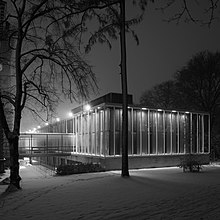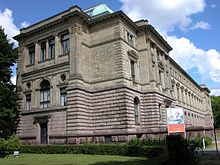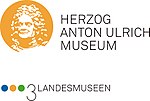Duke Anton Ulrich Museum
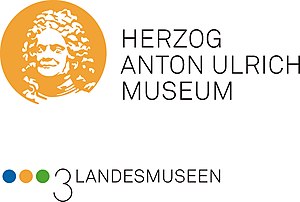 Entrance to the museum |
|
| Data | |
|---|---|
| place | Braunschweig , Germany |
| Art | |
| opening | 1754 |
| operator | |
| management |
Thomas Richter
|
| Website | |
| ISIL | DE-MUS-026819 |
The Herzog Anton Ulrich Museum , as it has been called since 1927 ( HAUM for short ), was opened in Braunschweig in 1754 . In its more than 250-year history, it has developed into one of the largest and most important art museums in Germany and one of the most important museums of ancient art in the Federal Republic of Germany . It is named after its founder, Anton Ulrich , Duke of Braunschweig-Wolfenbüttel (1633–1714). It shows around 4,000 works of art from 3,000 years of art history .
In 2010 an extension was added. The historic main building was completely renovated and reopened on October 23, 2016 after seven years of construction.
history
Emergence
The museum has its origins in the art and natural history cabinet of the Brunswick Duke Charles I , which he opened in 1754 at the suggestion of Daniel de Superville . It was initially located in the Kleiner Mosthof and was later moved to the Großer Mosthof . It was one of the first museums in Germany to be open to the public and opened just a year after the British Museum in London . This “cabinet” comprised a collection of handicrafts and sculptures from the Baroque and Renaissance periods , but also ancient works of art that did not come from Europe. The natural history collection later became the basis of the Natural History Museum .
The museum in the 19th century
In the 19th century, the museum was subject to numerous, sometimes dramatic changes. As early as the end of the 18th century, the poor building structure of the Salzdahlum Palace had become noticeable. Quick remedial action was needed. The situation was soon made worse by the fact that the state of Braunschweig was occupied by Napoleonic troops in 1806 , who kidnapped large parts of the most valuable works of art in the Louvre in Paris . As a result of the occupation by Napoleon's troops, Braunschweig was part of the Kingdom of Westphalia until further notice . In 1811 the King of Westphalia and Napoleon's brother Jérôme had the Salzdahlum Castle demolished.
However, in the course of the Wars of Liberation (1813-1815) Braunschweig regained its old independence and the stolen art treasures. However, the land was now impoverished and there was no longer enough space to store the art treasures. As a result, a way had to be found to store the works of art safely on the one hand and to get an appropriate and representative building for this important art collection on the other.
In 1882 an architectural competition was carried out and the new building began the following year. In 1887 the museum building, designed by the architect Oskar Sommer in collaboration with the then museum director Herman Riegel , was opened. Since then, the building has remained unchanged in its external appearance - similar to the neighboring Braunschweig State Theater, which was designed according to the style of the Italian Renaissance . The floor plan by Leo von Klenze's Munich Pinakothek was decisive for Sommer's designs . The museum park borders the building in the north to this day .
Compared to previous decades, stocks grew only slightly, not least due to a lack of money. The Reinike Collection was added in 1868, the Vasel Collection in 1910 and finally the Vieweg-Tepelmann Collection in 1944.
The museum after 1918
After the dissolution of the Duchy of Braunschweig in November 1918, the sponsorship of the museum was initially transferred to a foundation. After the end of the Second World War , responsibility was completely transferred to the state of Lower Saxony .
In 1927 the museum , previously known as the State Museum, was given its current name.
The museum suffered only minor damage to the building during World War II. After the war, the side wings of the building were occupied by the British military government . Far-reaching interventions in the building fabric took place when it was converted into an administrative building.
21st century
At the beginning of the new millennium it became clear that a comprehensive renovation of the museum building was inevitable. From 2008 to 2010 an extension with three floors and an area of 4,000 m² was built in the museum park behind the main building. The library and archive, the copperplate cabinet, workshops, a café and the administration are housed there.
From 2013, the main building was largely restored to its original state. It was completely renovated and equipped with modern exhibition technology. Since it reopened on October 23, 2016, it has been used exclusively for collections and exhibitions. Since then it has offered a larger exhibition area, so that more works of art can be shown than before.
The medieval collection is shown in Dankwarderode Castle . During the construction work until 2016, masterpieces from all collections were also presented in the special show “Epochal - Masterpieces of the Herzog Anton Ulrich Museum from Antiquity to the Present”.
Collections

The art collection moved from the Großer Mosthaus in 1765 to the Pauline monastery on Bohlweg in Braunschweig's city center, which was demolished in 1902 , where it continued to grow, for example by filling it with pieces from the (now also defunct) “ Grauen Hof ”, the Bevern art chamber and the castle Salt dahlum . The exhibits, at that time primarily purely representational items , mainly comprised bronze statues, art chamber objects , furniture, ivory carvings, majolica (largest collection of Italian majolica north of the Alps), enamel work (over 200 objects) and East Asian objects.
Painting collection

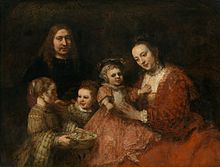
The collection has been expanded over the years mainly through the purchase of Dutch landscape paintings and still lifes .
The painting collection includes important works by:
Sculptures and handicrafts
This collection consists almost exclusively of the holdings that were collected by the Brunswick dukes, in particular Duke Anton Ulrichs and his son August Wilhelm .
For example, there are:
- The Herzog-Julius-Büchse, a partly gilded rifle (1580 to 1585)
- A desk by Hendrik van Soest (Antwerp around 1700)
- The mirror clock by Caspar Langenbucher (Augsburg 1649)
- The ball barrel clock by Christoph Rohr (Leipzig / Braunschweig around 1600)
Graphic collection
The Kupferstichkabinett was founded by Duke Carl I of Braunschweig and Lüneburg as part of the “Ducal Art and Natural History Cabinet” opened in 1754. These were parts of older ducal graphic collections. Duke Anton Ulrich was already collecting copperplate engravings in Salzdahlum Castle , which included works by Albrecht Dürer . From the beginning the focus was on contemporary graphics. Furthermore, Duke Carl I. bought up contemporary copper engravings from Germany, England and France. In 1764/65 acquisitions were made by the English moralist and satirist William Hogarth . An expansion of the collection was only made possible in 1765 by the art and natural history cabinet in the armory. In 1766 the museum acquired the two Rembrandt van Rijn volumes from the Wolfenbüttel library. These also contained copper engravings after Anton van Dyck , Raffael and Peter Paul Rubens . The further expansion of the Kupferstichkabinett took place until 1779. During this period, numerous new acquisitions were made. These included mostly contemporary graphics, but later also old master drawings. The driving force behind this expansion was the Duke himself. In 1795 the collection comprised a total of 1260 volumes with a total of 90,000 sheets. However, 54,000 of the existing sheets were removed and placed on cardboard in the second half of the 19th century. The hand drawings were to be limited to around 95 volumes around 1780. Of these, 20 volumes have been dissolved or are lost to date. The existing volumes also show missing pages. In total, the inventory recorded up to 18,000 comprised 9,585 drawings, 6,752 of which were in adhesive tape. These were kept on special shelves.
The Kupferstichkabinett achieved a significant increase in prints from the 15th to 19th centuries through the bequest of the important Brunswick graphic collector August Vasel. In 1928 the Kupferstichkabinett acquired the graphics collection of the Herzog August Library in Wolfenbüttel. This also comprised around 10,000 sheets of prints. Today the stock of prints comprises around 145,000 sheets. The collection of hand drawings can be numbered at almost 10,000 works. Furthermore, more than 1,000 illustrated books are kept in the Kupferstichkabinett. These mainly include splendid works from the Renaissance and Baroque periods .
The focus of the graphics collection is on the graphic arts of Europe from the late Middle Ages to the present day. The Dutch and German schools are best represented, followed by the graphics of Italy. Some graphics from North America are still represented in the 20th century. The graphics collection also preserves a smaller inventory of East Asian works, including a collection of Japanese woodblock prints. The collection is based on works from the 15th to 18th centuries. But in the Kupferstichkabinett - unlike in the collections of paintings, sculptures and handicrafts - art from the 19th, 20th and 21st centuries is collected with particular intensity. The prints were usually arranged in the volumes according to the person of the engraver or painter, according to the corresponding school or genre. A list in the inside cover provides information about the content. The hand drawings, on the other hand, were arranged in descending order of size. One of the best preserved volumes is volume 1a with the Duke's drawings for children and young people, which was first mentioned in 1766. However, this topic did not fill the entire volume, so for economical and pragmatic reasons it was supplemented with a good third, mostly anonymous, drawings by artists of the 16th and 17th centuries. The latest acquisitions are the 104 copper plates by the Augsburg graphic artist Johann Elias Ridinger , on permanent loan from the Lower Saxony Foundation in the holdings of the Kupferstichkabinett and complement the existing collection of 150 printing plates.
The stocks are recorded in inventory books or in catalogs. These are distributed in different rooms of the museum. The older works are in the collection of the Kupferstichkabinett. They are usually arranged according to a chronological overview and a linguistic overview. These have not been sorted according to meaning, but are on an equal footing. Furthermore, many works with inventory numbers can already be found in the online portal of the virtual Kupferstichkabinett.
Works of art on paper are extremely sensitive, which is why the graphic works in the “Epochal” exhibition in the Knights' Hall of Dankwarderode Castle are changed every three months. This offers the chance to rediscover the exhibition four times a year. A study room has been available to the Kupferstichkabinett since 2010. In the study room, the desired works are presented to each visitor for individual viewing. In addition, public graphics views are offered under scientific guidance. A room for the graphics is planned in the newly renovated building. School groups not only have the opportunity to look at the graphics, but also to observe the technology on site and then try it out for themselves. First, various prints are viewed and discussed together in the Kupferstichkabinett. Then, under the guidance of an artist, the students can take practical steps up to the creation of drypoint etchings.
The Virtual Kupferstichkabinett is a cooperation project between the Herzog Anton Ulrich Museum in Braunschweig and the Herzog August Library in Wolfenbüttel. The project received funding from the German Research Foundation (DFG). The aim is to make an overview of the virtual representation of the graphic collection accessible online. The database has been available online since September 2007. By the end of October 2011, over 45,000 graphic sheets had already been digitized and can be accessed online since then. The Virtual Kupferstich Kabinett works closely with the Photo Archive Photo Marburg . The database of the Virtual Kupferstichkabinett currently contains over 46,000 descriptions and images of prints from the 15th to 19th centuries. However, these are constantly being updated.
A broad insight can be obtained online on the Lower Saxony cultural heritage site . The portal offers multimedia access to selected and already digitally recorded cultural assets in the country and is constantly being expanded.
Picture gallery
- A small selection from all epochs:
Lucas Cranach the Elder , Heracles at Omphale
Christoph Bernhard Francke ,
portrait of Gottfried Wilhelm LeibnizGiorgione ,
self-portraitJan Kupecký ,
The Beautiful Polish WomanLucas von Leyden ,
self-portraitPeter Paul Rubens ,
Judith with the head of HolofernesRembrandt van Rijn ,
Thunderstorm LandscapeJohann Heinrich Roos ,
self-portraitAndreas Stech ,
walk in front of the gates of GdanskPhilips Wouwerman ,
rest on the falcon hunt
Movies
- Museum check with Markus Brock : Herzog Anton Ulrich-Museum, Braunschweig. Synopsis and video from 3sat . First broadcast: March 12, 2017
literature
- Lovis Corinth : The Ducal Museum of Braunschweig . In: Collected Writings . Gurlitt, Berlin 1920, pp. 76-79. ( Digitized version )
- Rüdiger Klessmann : Herzog Anton Ulrich Museum. Bruckmann, Munich 1978, ISBN 3-7654-1738-6 .
- Julius Krampe (Ed.): Directory of the painting collection of the Ducal Museum . Julius Krampe's court book printer, Braunschweig 1868 ( digitized version )
- Jochen Luckhardt : Herzog Anton Ulrich-Museum Braunschweig: The collection. Deutscher Kunstverlag, Munich 1995, ISBN 3-422-06122-3 .
- Jochen Luckhardt (Ed.): The Herzog Anton Ulrich Museum and its collections. Hirmer Verlag, Munich 2004, ISBN 3-7774-2295-9 .
- Jochen Luckhardt: 50 literary encounters with the Herzog Anton Ulrich-Museum Braunschweig and his works of art . Sandstein Verlag, Dresden 2016, ISBN 978-3-95498-256-1 .
- Alfred Walz: 250 Years of the Museum From the Princely Collections to the Museum of Enlightenment. Hirmer Verlag, Munich 2004, ISBN 3-7774-2155-3 .
Web links
- Website of the Herzog Anton Ulrich Museum
- Virtual print room of the Herzog Anton Ulrich Museum and the Herzog August Library
- Virtual coin cabinet of the Herzog Anton Ulrich Museum
- Herzog Anton Ulrich-Museum at Google Cultural Institute
References and comments
- ↑ https://www.braunschweig.de/kultur/museen/haum.html
- ↑ https://www.braunschweig.de/kultur/museen/haum.html
- ^ Jochen Luckhardt: Herzog Anton Ulrich-Museum Braunschweig: The collection. Deutscher Kunstverlag, Munich 1995, ISBN 3-422-06122-3 .
- ↑ Deutsche Bauzeitung , Volume 16, 1882, No. 82 (from October 14, 1882), p. 486.
- ^ Online city chronicle of Braunschweig, entry for May 19, 1927
- ↑ The name Landesmuseum was reassigned in 1938 by renaming the previous Fatherland Museum for Braunschweigische Landesgeschichte to Braunschweigisches Landesmuseum .
- ^ Renovation , accessed on February 25, 2014.
- ↑ The Herzog Anton Ulrich Museum , accessed on October 24, 2016.
- ^ The medieval exhibition in Dankwarderode Castle , accessed on October 24, 2016.
- ^ Herzog Anton Ulrich-Museum Braunschweig: The collection. Pp. 53-79.
Coordinates: 52 ° 15 ′ 48 ″ N , 10 ° 31 ′ 59 ″ E


